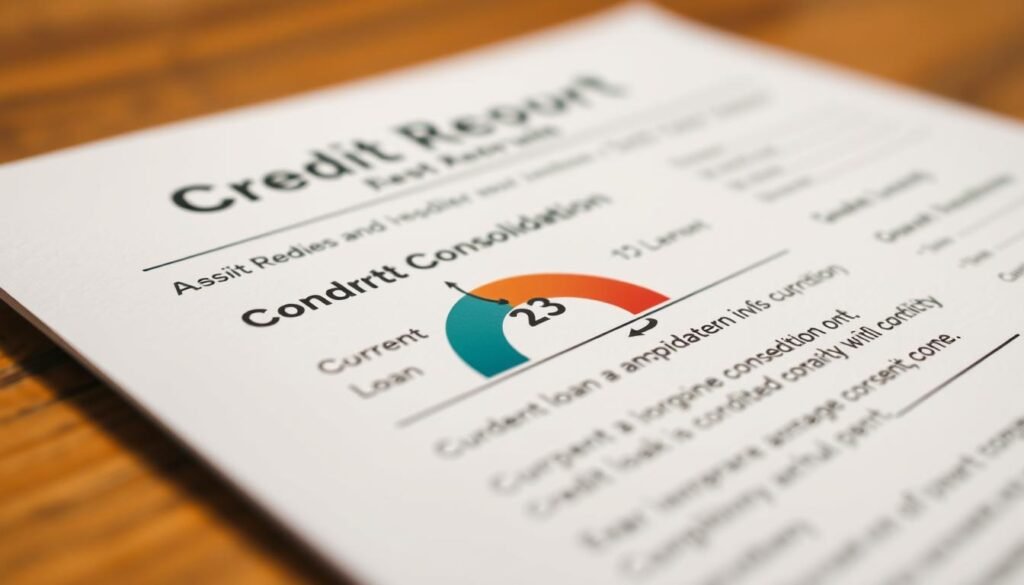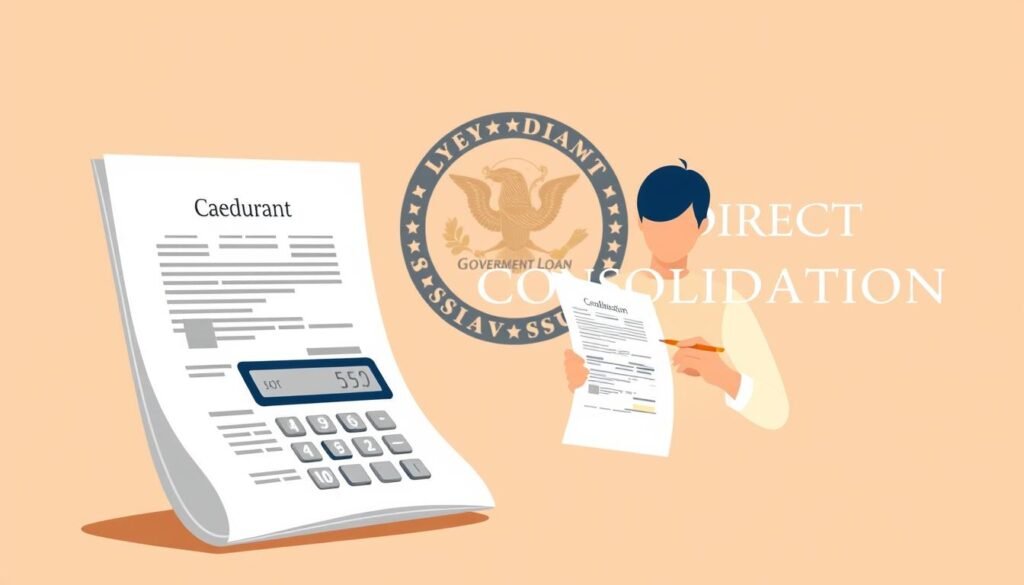
Student Loan Consolidation Impact on Credit Score: What You Need to Know

What if merging your balances helped your monthly budget but changed your path to forgiveness?
You need clear facts before you pick a path. Federal Direct Consolidation applies only to federal student accounts, sets a fixed rate by a weighted average (rounded up to the nearest one-eighth percent), and may extend terms to 10–30 years.
Private refinancing can lower your interest rate and shorten terms to 5–20 years, but it requires a hard credit check and may remove access to income-driven repayment and forgiveness programs.
This guide shows how loan consolidation and refinancing differ, how simplifying multiple loans can help you stay current, and which trade-offs matter for your financial goals.
Read on to learn options you can consider now and the steps that help protect your long-term credit health.
- Consolidation vs. Refinancing: What They Mean for Your Credit and Payments
- Student loan consolidation impact on credit score
- How federal Direct Consolidation works right now
- Should you consolidate or refinance based on your loans and goals?
- How to consolidate federal student loans with the Department of Education
- Protecting your credit score before, during, and after consolidation
- Alternatives if consolidation isn’t the best fit
- Choose a path that strengthens your credit and fits your financial situation
Consolidation vs. Refinancing: What They Mean for Your Credit and Payments
Deciding between federal Direct Consolidation and private refinancing starts with whether you prefer to keep federal protections or chase a lower rate.
How federal Direct Consolidation differs from private refinancing
Direct Consolidation through the U.S. Department of Education combines only federal loans, uses no credit check, and sets the interest as a weighted average of your existing rates rounded up by 0.125%.
That path keeps access to income-driven repayment and forgiveness programs you may rely on.
Why refinancing can change your rate, but consolidation can’t
Private refinancing, offered by a private lender, can include both federal and private debts. Lenders review your credit and may require a cosigner.
Refinancing can lower your interest rate or shorten repayment term (commonly 5–20 years), but it removes federal program benefits permanently.

"Refinancing can reduce monthly payments or total interest if your profile qualifies, but comes with trade-offs that matter long term."
| Feature | Federal Direct Consolidation | Private Refinancing |
|---|---|---|
| Eligible debts | Federal loans only | Federal + private loans |
| Credit check | No | Yes (hard inquiry) |
| Interest | Weighted average rounded up 0.125% | New rate based on profile |
| Terms | 10–30 years | Typically 5–20 years |
| Federal benefits | Retained | Lost if federal debts refinanced |
For a quick guide to options and next steps, visit studyfinance.org for tools that match choices to your goals.
Student loan consolidation impact on credit score
When you simplify multiple balances into one payment, the most immediate effect is often on how reliably you pay each month.

Positive effects: Simplified payments and stronger payment history
Simplifying payments makes it easier to pay on time. Payment history is about 35% of your FICO mix, so fewer missed dates means fewer negative marks.
Keeping one, consistent payment helps you build a cleaner record. Over months, steady on-time payments can raise your credit score.
Potential downsides: Shorter average age of accounts and new account on file
Creating a new account often closes older ones. That can shorten your average account age, which is roughly 15% of FICO, and may cause a temporary dip.
This dip usually fades as you add more positive history under the new account.
Hard inquiry nuances: Federal consolidation vs. private refinancing
Federal Direct Consolidation does not require a hard inquiry, so your score isn’t hit at application. Private refinancing generally includes a hard pull that can briefly lower your score.
- Consolidating student loans can reduce missed payments by simplifying your plan.
- New accounts and closed old accounts can shorten credit history and cause a short-term decline.
- Federal options avoid hard inquiries; private refinancing usually does not.
| Effect | Federal Direct | Private Refi |
|---|---|---|
| Hard inquiry | No | Yes |
| Payment simplicity | Single payment; reduces missed dates | Single payment; can lower monthly interest |
| Credit history age | May close old accounts; temporary dip possible | New account + inquiry; short-term dip possible |
| Long-term effect | Improves with steady on-time payments | Improves if you maintain payments and lower interest |
"Steady on-time payments are the strongest way to rebuild and grow your score over time."
How federal Direct Consolidation works right now
Federal Direct Consolidation bundles eligible federal balances into a single, fixed account managed through the Department of Education. You get one monthly bill and no credit check, since only federal student loans qualify.
Eligibility and included types
Most federal student loans are eligible, including Direct, FFEL, and Parent PLUS accounts. Consolidation can restore defaulted federal loans to good standing and may convert legacy debts so they qualify for repayment plans you previously couldn't use.
How the interest rate is set
The new fixed interest rate equals the weighted average of your existing rates. The Department of Education then rounds that number up to the nearest one-eighth of a percent (0.125%).
Trade-offs to weigh
Pros: You may unlock income-driven repayment plans and certain paths to loan forgiveness. Terms can stretch up to 30 years to lower monthly payments.
Cons: Some program-specific perks, such as Perkins cancellation options, may be lost after consolidation. Parent PLUS borrowers should check IDR rules for eligibility.

"Direct Consolidation can simplify repayment and restore federal benefits, but read the fine print before you apply."
| Item | What to expect | Why it matters |
|---|---|---|
| Credit check | No hard inquiry | Preserves your score from an application pull |
| Interest rate | Weighted average, rounded up 0.125% | Fixed rate based on your prior rates |
| Terms | 10–30 years | Longer terms lower payments but raise total interest |
| Program access | May unlock IDR and forgiveness | Can restore benefits for legacy loans |
Should you consolidate or refinance based on your loans and goals?
Your best choice depends on whether you value long-term protections or short-term savings.
Match your financial situation to a clear option: keep federal loans if access to income-driven repayment and forgiveness programs matters to your career. That path preserves benefits you might need later.
If you qualify for a lower interest rate and shorter terms, refinancing with a private lender can cut total costs. Private loans don’t carry federal protections, so refinancing them often makes sense when you want savings now.
Consider your credit and income. If your profile can’t get a better rate today, using federal consolidation may be a safer bridge while you build credit and steady income. Then you can revisit refinance options later.
- Weigh forgiveness programs against any rate gains.
- Think about monthly repayment needs versus long-term interest paid.
- Plan to reassess choices as your credit and income improve.
| Consideration | When to favor federal | When to favor private refinance |
|---|---|---|
| Program access | Keep federal for IDR and forgiveness programs | Private removes federal benefits |
| Cost savings | May increase total interest if term extended | Can lower interest and shorten terms if you qualify |
| Eligibility risk | No credit check; safer if credit needs work | Requires good credit and income; hard inquiry applies |
"If forgiveness is a realistic path for you, that benefit can outweigh small rate savings."
How to consolidate federal student loans with the Department of Education
Follow a clear checklist so you complete Direct Consolidation without surprises.
Gather your federal loans and servicer details. Start by listing each account number, current balance, and servicer contact. This helps you see which loans are eligible and which servicer manages each account.
Choose a repayment plan. Review repayment plans, including income-driven repayment plans, to align your monthly payment with your income. Use the plan tool to compare how term length changes your monthly payment and total interest.
Submit your Direct Consolidation Loan application
Complete the online application at the Department of Education site. Select eligible loans, pick a servicer, and confirm all details before you submit. There is no credit check.
- Your new fixed rate equals a weighted average rounded up to 0.125%.
- Extending the term can lower monthly payments but may raise total interest.
- Set up autopay and payment reminders to protect your score and avoid missed payments.
"Document every step and confirm the first due date with your servicer so nothing slips through the cracks."
For help comparing repayment options, see this short guide to the best repayment plans and pick the option that fits your goals.
Protecting your credit score before, during, and after consolidation
Start with simple steps to shield your credit while you evaluate consolidation or refinancing.
Build credit ahead of any private refinancing consideration
Pay down revolving balances and keep utilization low to improve approval odds with a private lender.
On-time payments matter most; they account for about 35% of your FICO. A steady record helps you qualify for better interest and terms.
Use autopay and budget strategies to keep monthly payments on track
Set up autopay and align due dates so monthly payments arrive when you have funds. This cuts missed payments and protects your history.
Consider biweekly payments or small extra principal payments when affordable to lower total interest.
Monitor your credit reports and score for changes post-consolidation
Check reports from Experian, Equifax, and TransUnion after a new account posts. Watch for closed old accounts, new inquiries, and any errors.
- Time refinance applications to avoid multiple hard pulls in a short window.
- Keep balances low on revolving accounts to support length of credit history and improved standing.
- Create a checklist: verify servicer details, confirm first due date, enable autopay, and review all three reports.
"Steady payments and low utilization are the clearest paths to stronger credit over time."
Alternatives if consolidation isn’t the best fit
Not every borrower benefits from combining accounts; other strategies may match your income and goals more closely.
Income-driven repayment: SAVE and other IDR programs
Income-driven repayment plans set payments by your income and family size for roughly 20–25 years.
Payments can be as low as $0, and qualifying borrowers may reach loan forgiveness after the term. Check eligibility and apply through your servicer.
Deferment and forbearance for short-term relief
These options pause payments when cash is tight. Interest may accrue, so keep mind the added total cost if you choose a pause.
Private refinancing: When a lower rate or different terms could help
Refinancing with private lenders can lower your interest rate or shorten terms, but it usually requires a hard credit check and removes federal protections if federal balances are refinanced.
Quick comparison:
| Option | Best if | Key trade-off |
|---|---|---|
| Income-driven repayment | You need lower monthly payments and may seek forgiveness | Longer term; forgiveness conditions apply |
| Deferment / Forbearance | Short-term hardship | Interest may accrue; total debt grows |
| Private refinancing | You can secure a better rate or term with strong credit | Lose federal programs; hard inquiry applies |
"Choose the path that eases your monthly budget while keeping future options open."
Choose a path that strengthens your credit and fits your financial situation
Pick a plan that keeps monthly payments manageable while protecting longer-term options. Balance lower interest and shorter terms against the federal benefits you may need later.
Check eligibility for federal student loans and for loan forgiveness programs before you refinance with a private lender. A hard inquiry can ding your score briefly, while federal consolidation has no credit pull.
Model monthly payment scenarios, compare interest rate offers, and weigh repayment term changes against total interest. Include special cases like PLUS accounts or IDR needs.
Then act: confirm loan types, estimate payments, and set autopay. The best choice protects your credit, keeps payments steady, and moves you toward debt freedom with confidence.
If you want to know other articles similar to Student Loan Consolidation Impact on Credit Score: What You Need to Know you can visit the category Consolidation.




Leave a Reply